

PostgreSQL, an advanced open-source database, is renowned for its versatility and support for both SQL and JSON.
Supporting features like JSON/JSONB and XML data types, efficient indexing for complex queries, multi-version concurrency control (MVCC), and full-text search, it is a reliable choice for developers tackling diverse and demanding applications.
However, on its own, PostgreSQL lack the dedicated reporting capabilities that many modern businesses require.
While it excels at data management and querying, PostgreSQL is not designed to function as a reporting or analytics tool, and its limitations in creating reports or automating document workflows can pose challenges for organizations with such needs.To bridge this gap, businesses often turn to specialized add-ons that can integrate with PostgreSQL and:
Good news? EDocGen offers exactly that.
Blending intuitive reporting features with automated document creation, the system simplifies tasks like scheduling reports and merging multiple data sources for more efficient workflows, helping users quickly move from data to tangible outcomes.
Let’s see how it all comes together.
Effective data reporting empowers organizations to make informed decisions, and PostgreSQL provides the flexibility to adapt and grow with your needs.
It simplifies shaping reporting systems around specific requirements, whether it’s handling large datasets, merging data from various sources, or integrating with third-party tools. PostgreSQL also pairs effortlessly with a range of reporting solutions, making it easier to create custom reports without starting from scratch.
Let’s see how PostgreSQL supports this:
PostgreSQL's open-source nature supports a rich ecosystem of tools, such as pgAdmin for database administration, PostGIS for geospatial data handling, and Barman for backup and recovery.
These tools often overlap in functionalities like data management, backup solutions, and geospatial analysis, enhancing PostgreSQL's versatility and making it suitable to address various reporting needs.
The flexibility of PostgreSQL allows users to define their specific reporting requirements and avoid investments in unsuitable solutions.
Whether you're a small team or a large enterprise, PostgreSQL can adapt to fit your unique data presentation needs through functionalities such as custom report generation, dynamic querying, and data visualization.
PostgreSQL reporting can produce custom solutions using programming languages like Python or R, allowing for highly customized reporting solutions.
This flexibility enables businesses to create specialized reports that align perfectly with their operational goals by leveraging features such as complex data manipulation, advanced analytics, and dynamic report generation.
These powerful features make PostgreSQL an excellent choice for generating accurate reports.
However, as business needs evolve, gaps may arise in managing complex analytics, creating visually detailed reports, or automating document workflows.
So, could these challenges indicate it’s time to explore more specialized solutions? Let’s find out.
As businesses expand, their reporting needs often become more intricate, requiring advanced features such as real-time analytics, interactive dashboards, and the ability to scale.
Many open-source tools lack these capabilities and struggle to keep up with growing data volumes and the demand for sophisticated insights due to limited infrastructure, a lack of enterprise-grade support, and reliance on slower community updates.
Despite offering flexibility and cost savings, open-source tools come with certain drawbacks that can impact business performance:
Features like white labeling, custom branding, or report personalization are often missing, making it harder for businesses to maintain a consistent brand identity.
Open-source tools can struggle to handle growing datasets, leading to slower query performance, delays in generating reports, and inefficiencies that impact decision-making.
Many open-source tools fail to provide features like predictive analytics, real-time insights, or interactive dashboards, making them less effective for modern business intelligence needs.
So, when should you make the shift?
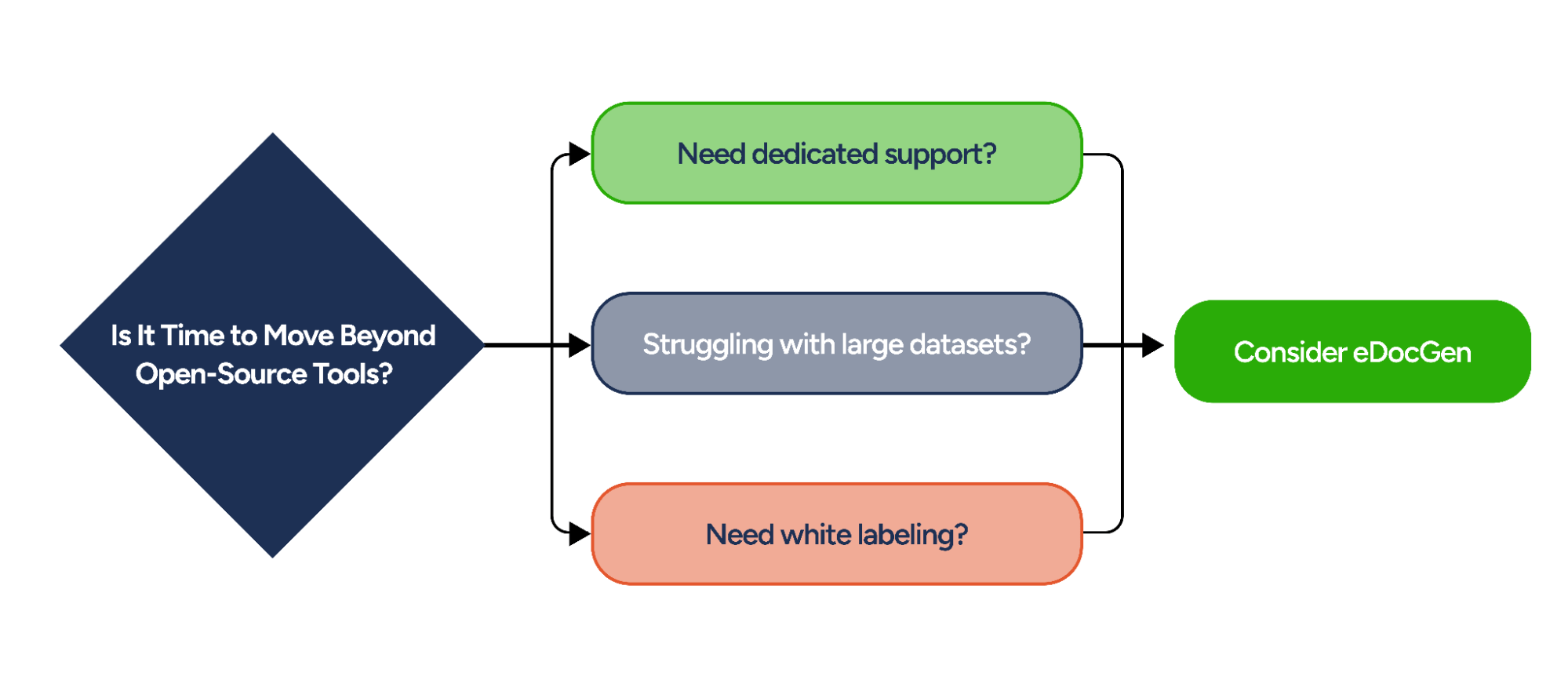
For example, EDocGen, as a document generation tool, helps embed advanced reporting and document generation functionalities into your existing software applications.
Its API allows for quick and clean integration with your SQL-based data sources, providing you with the most robust features needed to support your business needs.
Does that sound like what your business needs right now?
Keep reading to explore how EDocGen’s features can support you.
Naturally, the first thought for any PostgreSQL user is what they stand to gain by adding a document generation tool to their workflow.
To answer that, the platform offers many benefits, starting with smoother workflows and greater productivity, giving tangible results in no time.
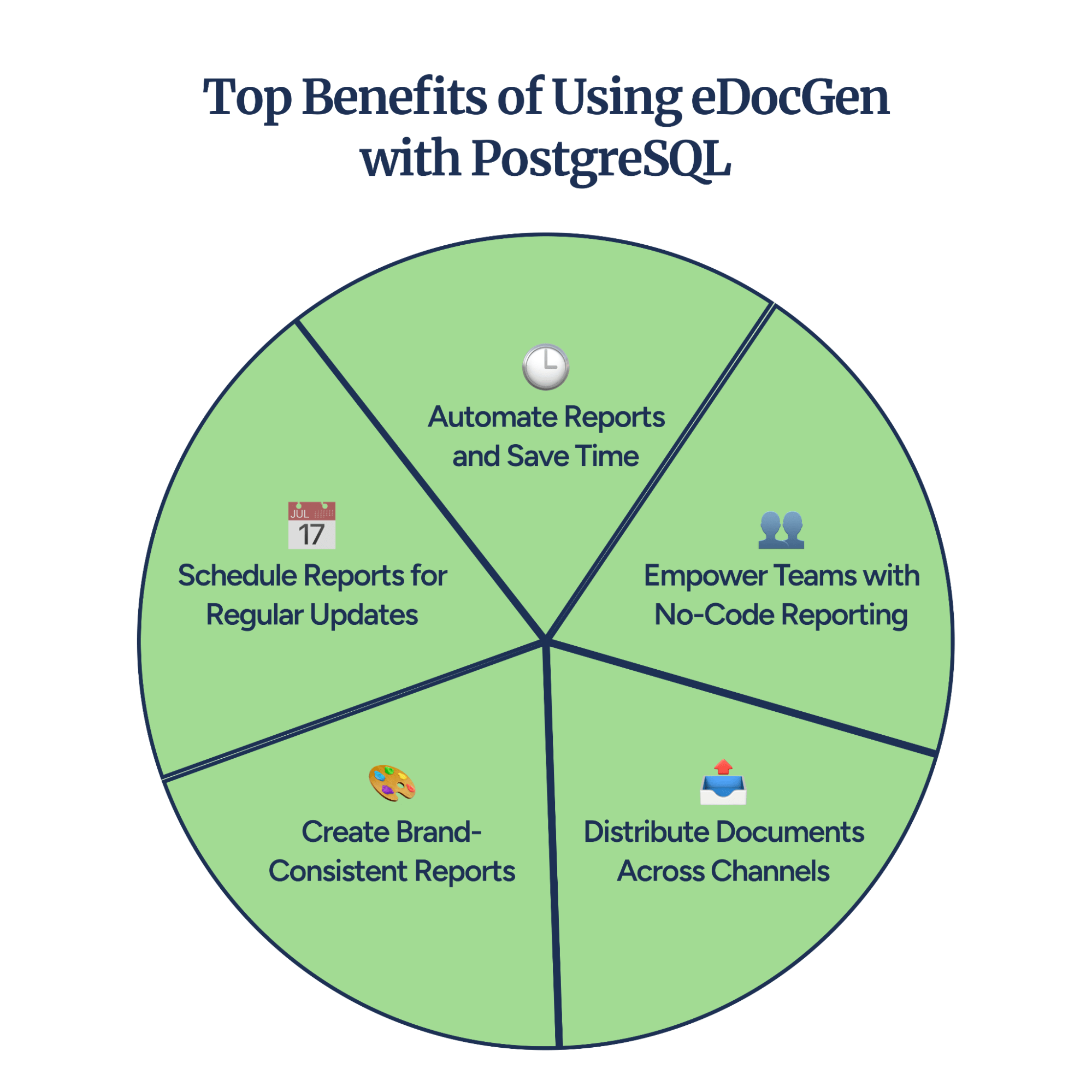
Let’s explore the key benefits users can start experiencing right away by adding it to their workflows:
Curious about how these benefits are achieved?
The following features make these advantages possible:
The system simplifies complex document workflows by eliminating the need for manual coding, making advanced reporting accessible to teams of all technical levels.
Here's how:
|
Feature |
What It Does |
|
User-Friendly Interface |
Allows business users to create documents and reports without programming knowledge. |
|
Reusable Templates |
Integrates tags for dynamic data visualization and faster report generation. |
|
Real-Time Data Sync |
Dynamically updates text within shapes and graphics based on live data. |
|
Direct PostgreSQL Integration |
Runs SQL queries, views, and stored procedures without manual processing. |
|
Multi-Source Data Connectivity |
Enables smooth integration with various data sources for streamlined reporting. |
|
SQL-Native Functionality |
Allows users to focus on analyzing data rather than complex data processing. |
|
Customizable Branding Options |
Ensures reports align with corporate identity for a professional, consistent look. |
|
Flexible Report Formats |
Supports charts, graphs, and tables without the need for complex scripts. |
|
Cost-Effective Reporting |
Balances performance with affordability for PostgreSQL users. |
By prioritizing data security with built-in safeguards, EDocGen's secure architecture ensures that your documents are shared and stored confidently.
Here's how it's achieved:
|
Feature |
What It Does |
|
Secure Document Sharing |
Protects sensitive PostgreSQL reports during distribution with built-in security protocols. |
|
Flexible Authentication Options |
Offers integrated security methods and standard PostgreSQL username/password verification for controlled access. |
|
Password Protected Documents |
Ensures documents are accessible only to authorized users by requiring passwords for access. |
Whether you're working on standard reports or complex documents, the system offers highly adaptable templates that fit diverse business needs, making it easier to manage content without compromising brand consistency.
Here's how it's achieved:
|
Feature |
What It Does |
|
Pre-Built Business Templates |
Enables rapid creation of financial statements, invoices, and operational documents without starting from scratch. |
|
Full Template Customization |
Allows effortless modification of data fields, design elements, and branding to meet specific business needs. |
|
Time-Saving Template Reuse |
Eliminates the need to design reports from scratch by enabling the reuse of existing document and report templates. |
Solving the original challenge, it transforms information into dynamic documents, bridging the gap between overwhelming data and meaningful reporting.
Here's how it's achieved:
|
Dynamic Content Feature |
What It Does |
|
Dynamic Content Tags |
Automatically updates text fields and visuals in real-time based on data inputs. |
|
Complex Data Representation |
Generates detailed tables, nested tables, charts, and graphs for advanced data representation. |
|
Comprehensive Media and Document Integration |
Supports Base64 images and BLOB data for dynamic insertion of paragraphs, RTF content, and sub-documents. |
So, you’ve seen what the system brings to the table, but how does it actually simplify document creation from start to finish?
Let’s break it down next.
It takes the hassle out of document generation by automating every step, from setting up templates to delivering polished, professional documents. Let’s walk through how it all works, step by step:
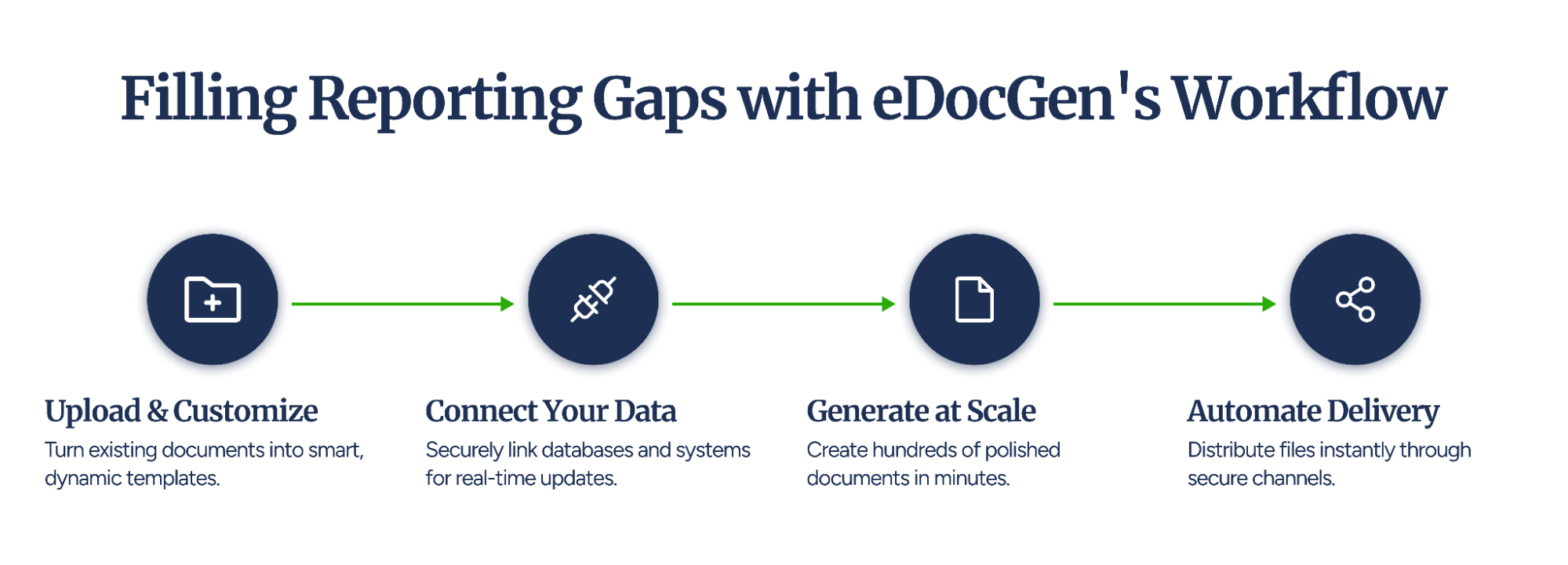
The first step is getting your templates ready to work for you.
Once your templates are set, the next step is connecting your data.
It simplifies the process of connecting to PostgreSQL and other data sources by allowing users to:
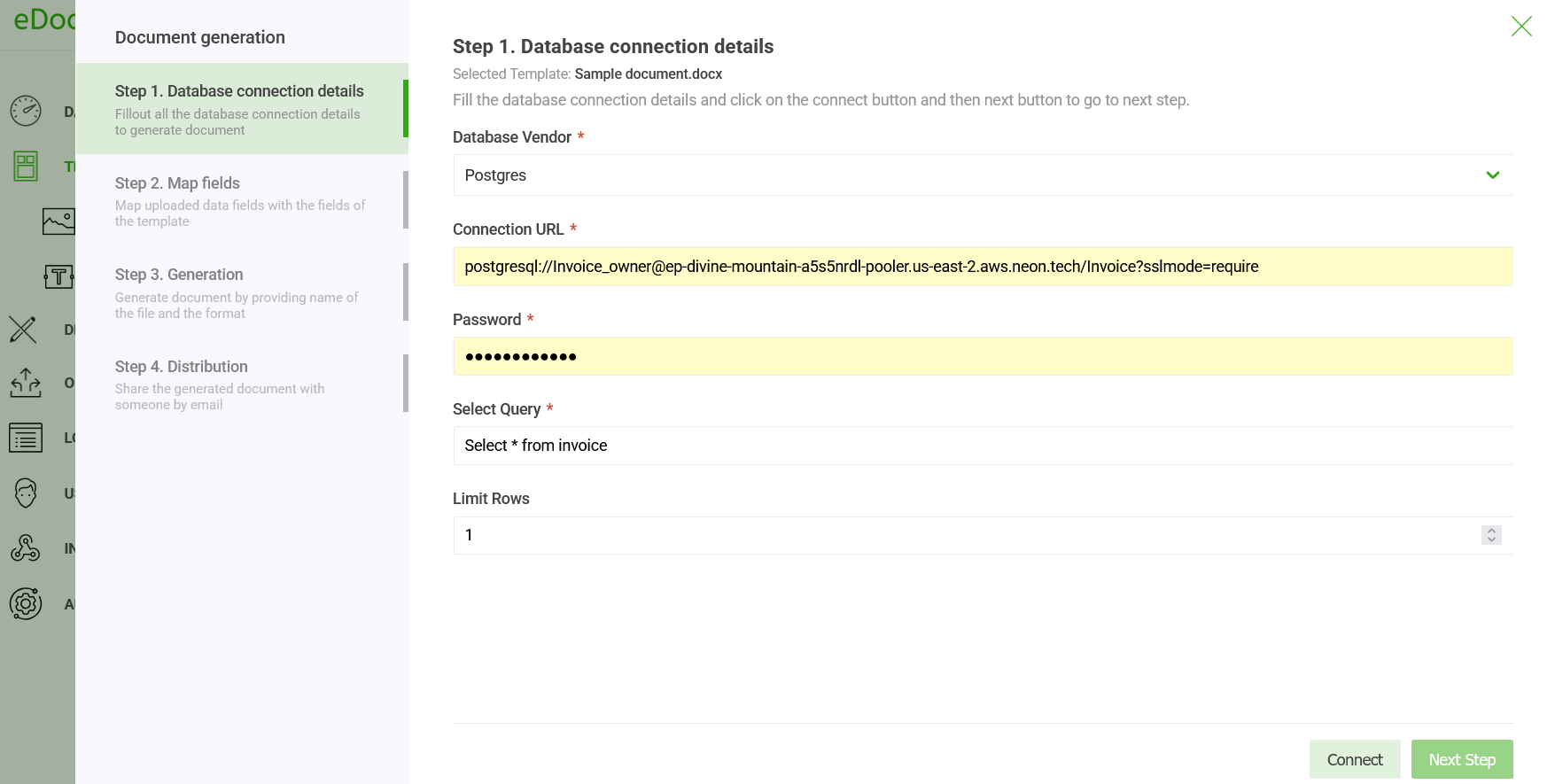
It makes it easy to merge data from various sources into one cohesive report by:
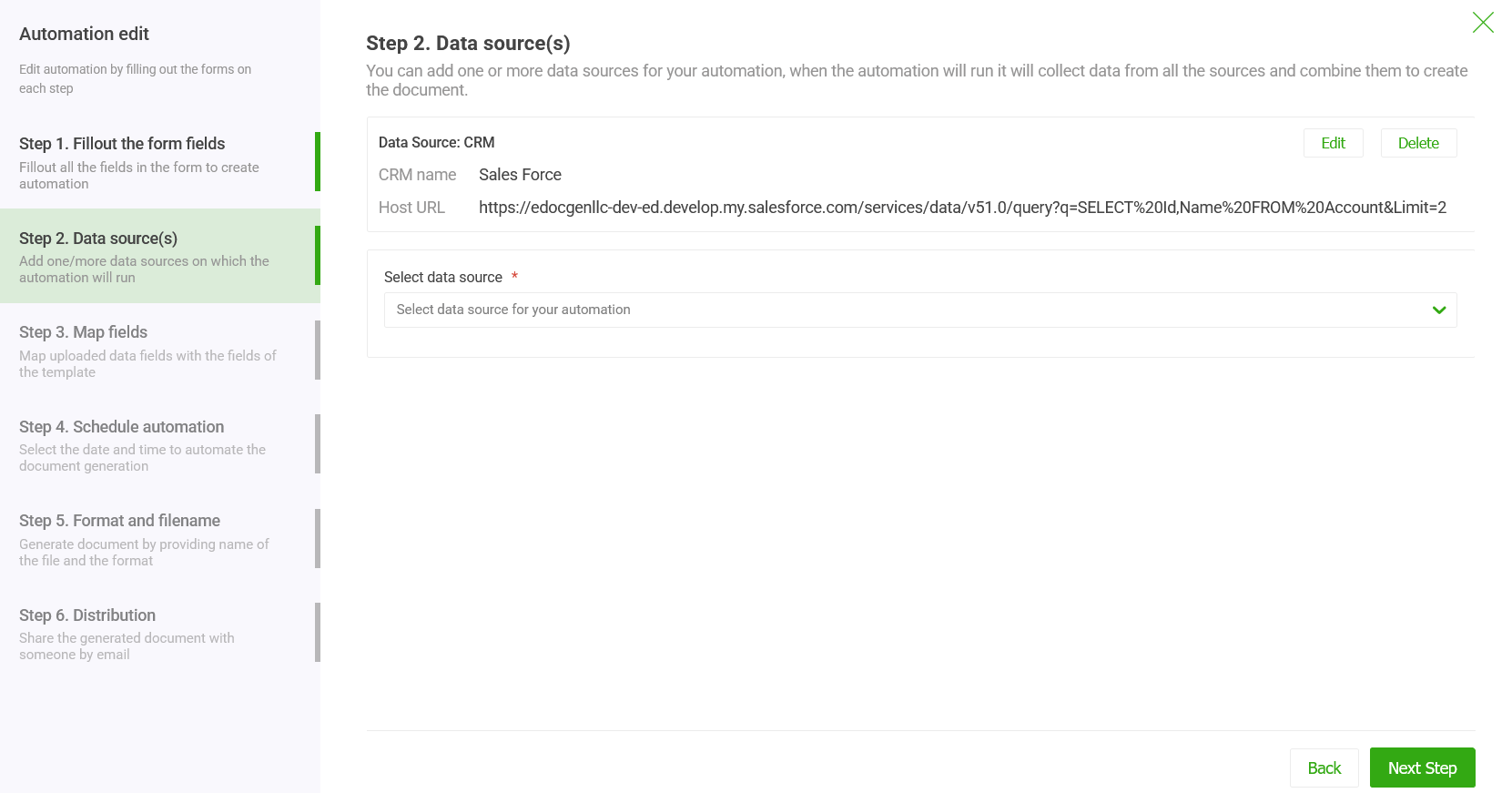
With your data connected, it’s time to generate your documents.
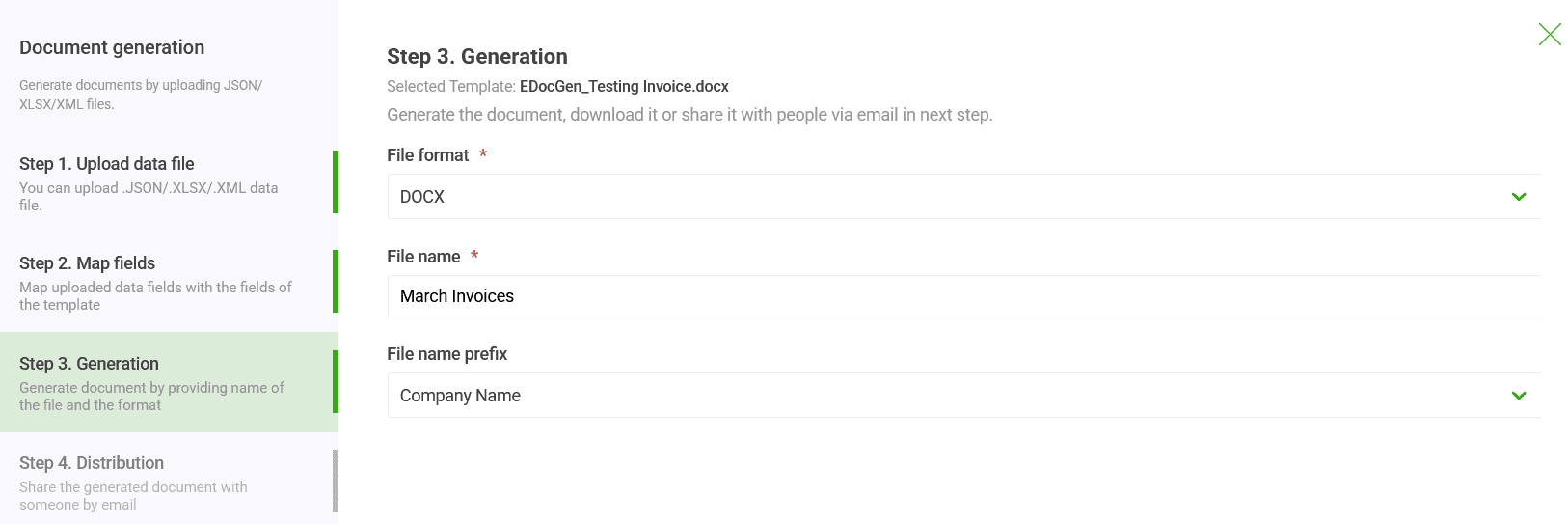
Once your documents are ready, the final step is getting them to the right people.
Now that we’ve covered the basics, let’s see how eDocGen handles the technical side of things.
Managing, syncing, and distributing your data across multiple sources can often be challenging for businesses.
Where slow processes and impacted decision-making make many businesses suffer, it eliminates these hurdles by connecting and syncing data from multiple sources, making document generation fast, efficient, and accurate.
Let's learn how:
Once your data is connected and synced, the system further transforms reports into professional, shareable documents by offering multiple output and distribution methods.
Generate professional documents in the format that best suits your needs:
|
Format |
Purpose |
|
|
Create fillable or standard PDFs with compression for professional sharing and secure storage. |
|
PowerPoint (PPT) |
Convert reports into visually engaging presentations for meetings or pitches. |
|
MS Word |
Export as editable Word documents for easy customization and internal collaboration. |
Once your document is ready, the system makes sharing simple with the following methods:
|
Method |
Purpose |
|
|
Instantly send documents to teams, clients, or stakeholders. |
|
E-sign |
Enable secure electronic signatures for official approval and validation. |
|
|
Generate high-quality printouts for physical distribution or record-keeping. |
Understanding the value the platform delivers is just the start.
Sure, it simplifies exporting and sharing documents, but it also helps you save time and lower expenses, offering significant cost savings in the long run.
Let’s explore how.
Companies that automate document generation see lower operational costs and save valuable time each week previously spent on manual reporting.
Hence, investing in a solution like EDocGen becomes as much about improving workflows in the short run as it is about long-term cost savings and measurable business impact.
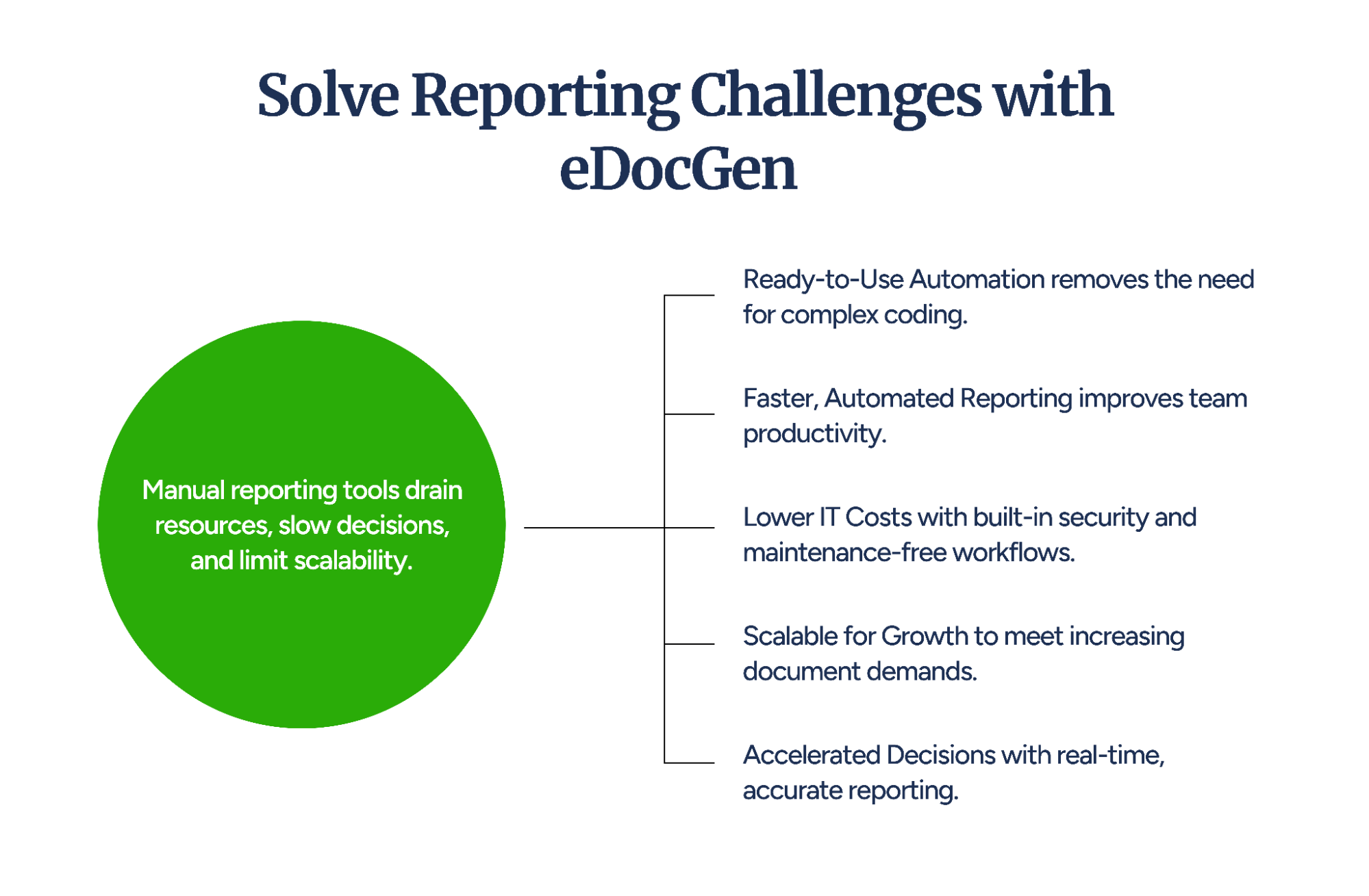
To fully understand the impact, have a look at the challenges of manual reporting with the benefits of automated document generation:
It eliminates the need for costly custom reporting solutions with its ready-to-use document automation, significantly reducing development expenses.
It automates report generation, freeing teams from repetitive tasks and saving valuable time for more strategic work.
It minimizes IT maintenance demands with built-in security features and scalable infrastructure.
It grows with your business, handling high-volume document generation without requiring extra infrastructure.
With faster report generation, the system speeds up data-driven decisions and improves overall business agility.
At this stage, we also make it easy to turn that synced data into polished, shareable documents.
Let’s conclude why making the switch can transform how your business handles reporting and document generation.
We’ve explored how the system simplifies document generation and enhances PostgreSQL reporting, but the real advantage is how it transforms PostgreSQL from a powerful database into a complete, automated reporting solution.
Here’s how it can help:
So, if managing reports and documents feels like a hassle to you today, the system can help make things easier.
Book demo to see how you can save time and improve your PostgreSQL workflows.